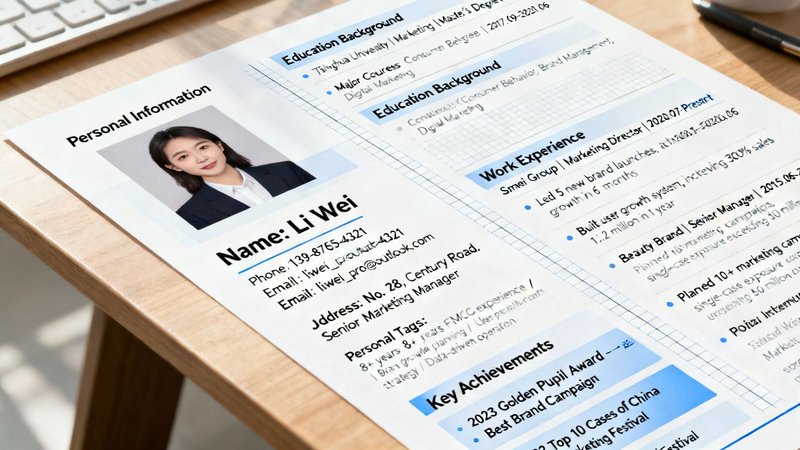
Your Small Business Marketing Strategy Guide
Build a small business marketing strategy that works. This guide offers practical, no-nonsense tips for real results, designed for Australian business owners.
20 Oct 2025
Feeling lost in the Australian job market? This guide has real, practical steps on how to get a job, from fixing your resume to nailing the interview.
Blog
Getting a job in Australia isn't about firing off a hundred resumes and hoping for the best. That's a one way ticket to burnout city.
You need to define what you truly want, build a resume that screams impact, network like a human, nail your interviews, and negotiate the offer you deserve. It’s a game of strategy, not just numbers.
Let's be real for a second. Looking for a job right now feels a bit strange, doesn't it?
One minute you hear the market is booming, the next you're sending applications into a black hole. It’s completely draining. You spend hours tweaking your resume, writing yet another cover letter that feels like a carbon copy of the last one, and then... crickets. Or worse, you get that polite, soul-crushing rejection email that just makes your stomach sink.
I get it. I’ve been there. Staring at the screen, wondering if anyone is even reading what you're sending. This isn't just another generic guide filled with obvious tips. This is a real-world chat... like we're grabbing a coffee... about what it actually takes to find a great job in Australia today.
We'll look at the current landscape, not to get bogged down in data, but to set some realistic expectations. For example, recent figures show the Australian unemployment rate holding steady at 4.2%, with about 647,400 people officially unemployed as of August 2025. It’s also interesting to see that while the number of people looking for part-time work has slightly dropped, more people are now seeking full-time roles. You can dig into more Australian job market trends if you're curious about the specifics.
The point isn't to memorise statistics. It’s to understand that while there's competition, there are also plenty of opportunities if you know where... and how... to look.
This is all about building a smarter job search strategy. One that protects your energy and actually gets you closer to an offer. It's about focusing your efforts where they'll have the most impact. For instance, understanding the nuances of a specific field, like the marketing industry in Australia, can give you a massive edge over someone applying for anything and everything.
Our goal here is simple.
Forget the scattergun approach. We’re going to be targeted. We’re going to be strategic. And we’re going to get you a job you actually want. Let's get started.
Okay, let's hit pause for a second. Before you fire off another application, we need to talk. What do you actually want?
It’s way too easy to get sucked into the job search vortex. You know the one... you start applying for anything that looks remotely suitable, your standards begin to slip, and before you know it, you're tailoring your resume for a role you know deep down would crush your soul. That’s a fast track to burnout. We're not doing that.
This part is all about a practical self-audit. Forget the cheesy ‘find your passion’ speeches that feel totally out of reach. We’re talking about getting real about what tasks give you energy versus which ones make you want to stare at a blank wall. It's about building your own job compass.
The idea is simple: create a filter. A personal checklist that stops you from wasting precious time and emotional energy on the wrong opportunities. This lets you focus your efforts where they'll actually make a difference... on roles you won’t just tolerate, but might actually enjoy.
Let's break it down into three core areas. Seriously, grab a notepad or open a new note on your phone.
This straightforward exercise helps you map out the essential parts of a fulfilling role, moving from your personal energy to team dynamics and finally to your practical, must-have needs.
The infographic above clearly lays out a path for self-reflection that’s vital before you get serious about how to get a job. This isn’t about finding the 'perfect' role, because that probably doesn't exist. It’s about finding the right role for you, right now.
Knowing what you want is the most powerful tool you have in your job search. It turns you from a passive applicant into an active career architect, someone who is choosing their next step with intention and confidence.
Once you have this clarity, your entire job search changes. You’ll start reading job descriptions with a completely different eye. Instead of just glancing at the title and salary, you’ll be scanning for clues about the day-to-day work and the company culture.
This clarity might even shine a light on career paths you hadn't considered before. You might realise the parts you loved about your last sales job weren't about hitting targets, but about building relationships and crafting compelling stories... which are key skills in marketing. If that sounds familiar, it might be worth exploring if you should consider marketing as a career to see if the daily grind aligns with your energy list.
Having this personal framework makes the whole process feel so much less overwhelming. You're no longer drowning in a sea of endless listings. You have a filter. You have direction. And that, my friend, is how you start to take back control.

Let's get one thing straight. Your resume isn't a boring historical document or an autobiography.
It’s a marketing brochure. And you are the product.
Most resumes are just a laundry list of duties. "Managed social media," "Answered customer queries," "Organised team meetings." They get skimmed in seconds and then tossed onto the 'maybe' pile... or worse, the 'no' pile. We're going to fix that.
The entire goal is to shift your mindset. Don't just tell them what you did. Show them the impact you made.
This is the single biggest change you can make, and it’s a total game-changer. It's the difference between blending in and standing out.
Think about it like this. Instead of saying:
You reframe it to show the result:
See the difference? One is a chore, the other is a victory. The second one makes a hiring manager sit up and think, "Hmm, this person gets results." That's what you want.
Your resume needs to answer the hiring manager's silent question: "Why should I care?" Every single bullet point should be an attempt to answer that question with a clear, quantifiable achievement.
So, how do you do this? Go through your current resume, line by line. For every duty listed, ask yourself "so what?".
"I managed the company blog." So what? "Well, my articles increased website traffic." So what? "We got 20% more visitors each month, which led to more sales leads." Ah, there it is. That's your bullet point.
Okay, a little tangent. Before a human even sees your resume, it often has to get past a robot. This is the Applicant Tracking System, or ATS.
Its job is to scan your resume for keywords from the job description. If your resume doesn't have the right words, it gets filtered out before a person ever lays eyes on it. It’s a harsh reality of trying to get a job in this market.
This is why the one-size-fits-all resume is a myth. It just doesn't work anymore.
You need to tailor your resume for every single job you apply for. I know, I know. It sounds like a lot of work. But would you rather send out 100 generic resumes and hear nothing, or 10 tailored ones and get a few interviews?
Here’s the simple process:
This isn’t about tricking the system. It's about speaking the same language as the employer so the robot... and the human... can see you're a perfect match.
Finally, let's talk about looks. Your resume needs to be clean, professional, and easy to skim. No one has time to decipher a cluttered, wall-of-text document.
Use a simple font, clear headings, and lots of white space. Bullet points are your best friend. They break up the text and make your achievements pop.
And remember, your resume is just one piece of the puzzle. While your resume highlights your qualifications, an engaging online portfolio can visually demonstrate your skills and projects, significantly improving your chances of getting hired. If you're in a creative or project-based field, you'll find great tips to create an online portfolio that gets you hired that can give you a real edge.
At the end of the day, your resume is your first handshake. It’s your chance to translate your past experience into future value for an employer. Make it count.

The word 'networking' can make you physically cringe. It conjures up images of stuffy events with lukewarm sausage rolls and conversations that feel about as genuine as a three-dollar note.
We've all been there. Awkwardly trying to make small talk, feeling like you need to 'sell' yourself. It’s exhausting and, frankly, it rarely works.
So, let's reframe it. Forget 'networking'. Think of it as just... having conversations. It’s not about collecting business cards or boosting your LinkedIn connection count. It's about making real, human connections with people who are doing interesting work. That's it.
LinkedIn is an incredible tool for finding your next role, but most people use it like a digital resume collection. Scrolling, liking, and maybe firing off a generic connection request into the void.
Let's stop doing that. Instead, we'll use it strategically to connect with people at companies you genuinely admire. The key is to be thoughtful.
When you send a connection request, always add a personal note. Never just hit the button. This is your chance to stand out from the 99% of people who don't. Your note doesn't need to be an essay, just something that shows you've done a tiny bit of homework.
Here are a few ideas that actually work:
Notice what these all have in common? They're not asking for a job. You're just starting a conversation.
Once you're connected, the next step might be asking for a brief 'informational chat'. This is where a lot of people get nervous. They don't want to seem needy or like they're begging for a job.
The secret is to frame it around their expertise, not your needs. You're asking for advice and insight, not a job referral. People genuinely like talking about their work and sharing what they've learned.
The goal of an informational chat is to learn, not to ask for a job. If you build a genuine connection and they think you're a good fit, they will often offer to help without you even asking.
Here's a simple script you can adapt after you've connected and maybe had a brief interaction (like commenting on one of their posts):
"Hi [Name], thanks again for connecting. I'm really inspired by the career path you've taken in [Their Field]. As I'm looking to grow in this area myself, I was wondering if you might have 15 minutes in the coming weeks for a brief virtual coffee? I'd love to hear a bit more about your experience at [Their Company] and any advice you might have for someone in my position. No worries at all if you're too busy!"
This approach is respectful of their time and takes the pressure right off.
Don't forget the people you already know. Seriously. Your immediate network of old colleagues, university friends, and even family friends is often way more powerful than you think. This is your 'warm' network.
These people already know you, trust you, and are likely willing to help. You don't need a fancy script here. Just be real. Reach out and let them know you're looking for a new role in [Your Field] and ask if they know anyone they think you should chat with.
It's a simple, low-pressure way to get introductions. And an introduction from a trusted connection is a thousand times more effective than a cold application. It immediately moves you from the anonymous resume pile to a real person with a story.
Alright, this is it. The interview. All your hard work... the soul-searching, the resume tweaking, the networking... it all leads to this moment. It’s your chance to be more than just a name on a page and show them who you really are.
But let’s be honest, interviews can be incredibly nerve-wracking. Sweaty palms, a mind that suddenly goes blank… we’ve all been there.
The antidote to that anxiety is preparation. I’m not talking about memorising robotic, perfect-sounding answers that make you sound like every other candidate. True preparation is about deeply understanding the company, the role, and exactly how your unique story fits into their world.
You know they're coming. Those classic questions pop up in almost every interview, so having a strategy is far better than having a script.
Let's start with, 'Tell me about yourself'. This isn't an invitation to recite your life story. Think of it as your professional highlights reel, lasting about 90 seconds. Your goal is to briefly connect your past experiences to this specific role you're going for.
Then there’s the dreaded, 'What's your greatest weakness?'. Please, don't say you're a perfectionist. Everyone says that. Instead, pick a real, minor weakness you've actively worked on. Maybe you used to struggle with public speaking, so you joined a local Toastmasters group to build your confidence. That shows self-awareness and a proactive attitude.
When they ask behavioural questions like, “Tell me about a time you handled a difficult situation,” they’re looking for proof, not just claims. This is where the STAR method is an absolute game-changer.
It’s a simple framework for telling a compelling story about your skills in action.
Practising a few STAR stories before your interview will make a world of difference to your confidence. You won't be scrambling for an answer; you’ll have powerful, real-world examples ready to go.
Remember, you're interviewing them just as much as they're interviewing you. This isn't a one-sided interrogation. You need to figure out if this is a company where you’ll genuinely thrive.
So, always have questions prepared for the end. Not asking anything can signal disinterest. Your questions show you’ve done your homework and are seriously considering your future with the company.
Having thoughtful questions prepared does more than just get you information. It subtly shifts the dynamic, positioning you as a discerning professional who is evaluating them as a potential employer, not just a desperate job seeker.
This is also where local context matters. For instance, Australia's labour market has significant regional variations. The Australian Bureau of Statistics points out that job conditions in major cities like Sydney and Melbourne are often quite different from those in regional areas, which can affect things like company growth and team stability. Understanding these local dynamics can help you ask smarter questions. You can find more details by checking out the latest Australian labour force data.
Wondering what to ask? Think about what truly matters to you. For a little inspiration, check out our guide to 6 awesome job interview questions that go beyond the obvious. It will help you dig into company culture, team dynamics, and what success really looks like in the role.
This is your moment to shine. Go in there prepared, be yourself, and show them the incredible value you bring. You've got this.
You got the offer! First things first, take a moment to celebrate. Seriously. Pop something bubbly, do a little happy dance in the kitchen… whatever your celebration looks like. Landing a new role is a huge win.
But don't sign on that dotted line just yet.
Now comes the crucial, and often nerve-wracking, step of navigating the offer and talking money. A lot of people, especially here in Australia, feel a bit hesitant to negotiate. It can feel awkward or demanding, but trust me... it’s an expected and normal part of the process.
Let's talk about how to approach this conversation professionally, without the anxiety.
It all starts with knowing your value in the current market. Going into a salary talk based on a gut feeling or what you think you deserve is like navigating without a map. You need data.
Your mission is to research the typical salary benchmarks for your specific role, in your city, with your level of experience. There are great online resources for this. Look at salary guides from recruitment agencies, check out sites like Glassdoor, and even talk to trusted mentors in your industry.
Negotiation isn't about demanding more; it's about confidently articulating your market value. When you have the data to back it up, the conversation shifts from a personal request to a business discussion.
Once you have a clear salary range in mind, you can approach the conversation with facts, not just feelings. This completely changes the dynamic.
The salary is obviously the big-ticket item, but it's not the only thing on the table. Think about the entire package. Sometimes a company might not have much wiggle room on the base salary, but they can be flexible elsewhere.
What else could make the offer more attractive for you?
This is especially important in the current economic climate. Real wage growth in Australia has remained pretty modest recently. As of early 2025, real hourly wages were still 4.4% below what they were in early 2021, before the big inflation surge hit. You can read more about Australian wage trends from the OECD to get the full picture.
Because of this, negotiating for benefits that improve your work-life balance or boost your skills can be just as impactful as a few extra dollars in your pay packet.
When you make your counter-offer, always frame it around the value you bring. Connect it back to the problems you discussed in the interview and how your specific skills will solve them. This isn't just about what you want; it's about what you're worth to them. Getting this conversation right can have a massive, positive impact on your career for years to come.
Alright, let's tackle a few of those nagging questions that always seem to pop up during the job search. It's easy to get bogged down in the details, so think of this as a quick chat to clear up some common tricky spots and get you back on track.
There's no single magic number, but a good rule of thumb is to aim for two pages if you've got a decent amount of experience under your belt. For recent graduates or anyone early in their career, one page is often perfect.
The real key here is relevance, not length. A sharp, impactful one-page resume will always beat a rambling two-page document filled with fluff.
Yes. Always. Every single time.
Think of an ‘optional’ cover letter as a secret test of how much you actually want the job. It’s your best chance to stand out from the sea of candidates who couldn't be bothered. It lets you tell a story your resume can't and connect your skills directly to the problems they need to solve.
Beyond the traditional application, it's crucial to understand the impact of your digital footprint on job opportunities and what employers really look for. Your online presence can be just as telling as a cover letter.
Absolutely! In fact, you should. A good timeframe is about a week after the date they said they’d get back to you.
A brief, polite email is all it takes. It keeps you top of mind, reiterates your interest, and shows you're proactive without being pushy.
Ready to build a marketing team that drives real results? Cemoh connects you with the top 1% of pre-vetted marketing talent in Australia, from fractional CMOs to specialist freelancers. Find your perfect match in just 48 hours at https://cemoh.com.
Here are some suggested articles that are closely related to this post

Build a small business marketing strategy that works. This guide offers practical, no-nonsense tips for real results, designed for Australian business owners.

Need a marketing consultant for small business? Discover expert tips and guidance to boost your small business marketing success today.

Explore how a fractional CMO Australia can elevate your marketing strategy, reduce costs, and drive growth for your business. Find out more now!

Feeling stuck? Discover practical, low-cost small business marketing ideas you can use today. Real examples for Australian businesses.

With so many frameworks and strategies floating around, why care about these seven? Because they keep things real.

Portfolio careers are no longer a fringe movement. They are fast becoming the go-to path for ambitious marketing professionals who want freedom, variety, and control. If you are exploring new ways to work, this is the shift you cannot afford to ignor